Customizing Templates and Formatting Elements in MS Project 2013
In this article, we are going to show you how to format elements of the Project screen, as well as teach you to create customized templates.
Formatting Text Boxes
On the Network Diagram view, you've seen the little boxes that comprise the look and feel of it. This view uses different shapes to represent different task types.
-
Summary Tasks use a slanted box shape and include a plus or minus symbol. Whether it is plus or minus depends on whether subtasks are shown or not.
-
Subtasks are in rectangular boxes.
-
Milestones are in diamond shaped boxes.
Project allows you to change the formatting by individual box or type.
To do this, go to Network Diagram View (View>Network Diagram).

Right click on the task you want to change, then select Format Box. (If you want to change all boxes, right click outside of the task boxes and then select Box Styles.)
You will then see this dialogue box:

If you want to change the border style, you can do that in the Border section of the dialogue box by changing the shape, color, and width.
To change the background area inside the box, change the color or pattern (or both) in the Background section.
Click OK when you are finished.
Adjusting the Layout
In addition to changing text boxes, you can also change the layout of your view. Of course, your options in changing the view vary greatly from Network Diagram to Gantt chart to Calendar.
To view the Layout dialogue box for a view, right click in the area of the view, then select Layout.
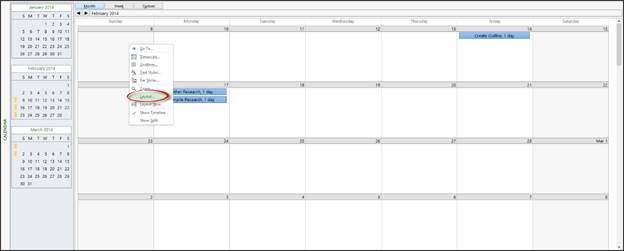
Below is the Layout dialogue box for Calendar view.
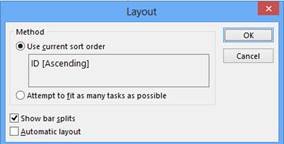
You can see the Layout dialogue box for the Network Diagram view in the next snapshot.
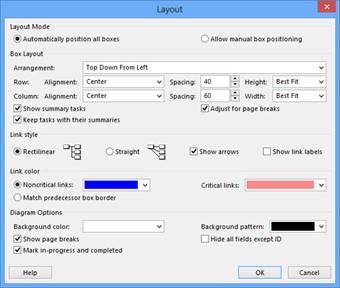
And for the Gantt chart view (right click inside the graphic area, NOT the table/spreadsheet area):
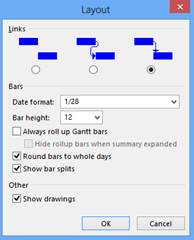
The settings in all three dialogue boxes allow you to change how the elements are arranged on the page and how dependency links are shown.
You could spend time playing around with the options for each view, and you are certainly welcome to do that. However, for now, we are going to present the formatting options given to you with each view and explain what it does.
|
Layout Type |
Option |
Use |
|
Calendar View |
Use Current Sort Order |
Uses the latest sort order applied to tasks |
|
Attempt to Fit as Many Tasks as Possible |
Ignores the sort order. Fits as many tasks into a date box as possible. |
|
|
Show Bar Splits |
Whenever you have a task that shows periods of inactivity, this task can be displayed as split into different parts over the time it takes to complete. |
|
|
Automatic Layout |
Modifies the layout to accommodate the insertion of tasks |
|
|
Network Diagram View |
Layout Mode Area |
Allows for automatic or manual positioning |
|
Box Layout Area |
Allows you to align boxes, adjust alignment, spacing, and height. You can also modify how summary tasks will be displayed. |
|
|
Link Style Area |
Allows modification of the styles in which dependency link lines and labels appear. |
|
|
Link Color Area |
Sets color for links |
|
|
Diagram Options Area |
This controls the background color and pattern for the boxes. It also controls how page breaks as well as progress on tasks are shown. |
|
|
Gantt Chart View |
Links |
Style of lines for the dependency links |
|
Date Format |
Changes the format used to display the date in task bars |
|
|
Bar Height |
Adjusts the height of the task bars (in points) |
|
|
Always Roll up Gantt Bars |
If you select this option, taskbar details will roll up to the highest level summary task. |
|
|
Round Bars to Whole Days |
Just as it sounds, this allows Project to round bars up so only whole days appear. |
|
|
Show Bar Splits |
Whenever you have a task that shows periods of inactivity, this task can be displayed as split into different parts over the time it takes to complete. |
|
|
Show Drawings |
If you include drawings, they will be displayed on screen and in the printed version. |
Modifying Gridlines
To modify gridlines, go to the area of any view that contains a grid, such as in Gantt chart or Calendar view.
Right click and select Gridlines, as shown in Gantt Chart view below.

You will then see the Gridlines dialogue box.
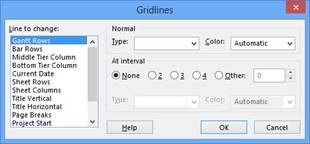
In the Line to Change list, select the gridline that you want to change.
In the Normal section, Type and Color allow you to select line style and color.
At Interval allows you to use a contrasting color at various intervals in the grid so that it is easier to read.
Click OK when you are finished.
Adding Shapes
You can use the Drawing toolbar to draw images in the chart area of Gantt chart view.
To do this, go to Gantt Chart view, then go to Format>Drawing and click the dropdown arrow.

Choose what shape you want to draw:
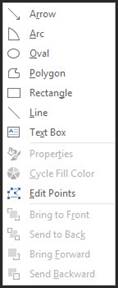
Click in the area of the chart where you want to add your drawing and drag your mouse until the drawing appears as you want it.
Release the mouse button.
Creating Filters
To create a filter, go to Gantt chart view. Display the fields or columns that you want to filter.
Click the arrow on the column you want to filter.
You can see the arrows in the column headings in the next snapshot. We've highlighted them for you.

We are going to select Task Name and put a filter on it.
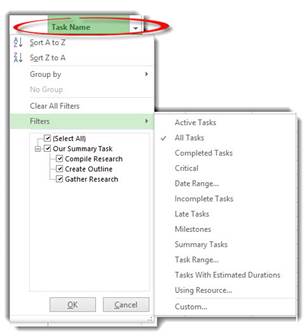
Select the criteria you want for the filter, or click Custom. When you click Custom, this dialogue box appears:
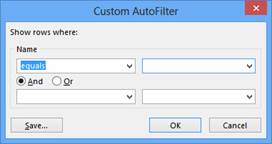
In the above box, you can set choices that are specific to each field of information.
Click OK when you are finished.
Creating Customized Filters
The filters we've just used are predesigned filters. You can also create your own. Here's how.
Go to the View tab, then go to Filter in the Data group. Select More Filters from the dropdown menu.
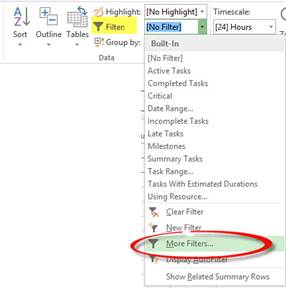
The More Filters dialogue box will appear, as shown in the following snapshot.
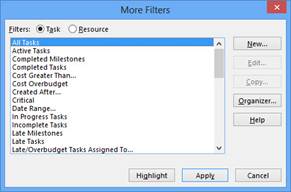
Choose either the task or resource to let Project know which list of filters that you want to include your new filter in.
Click the New button.
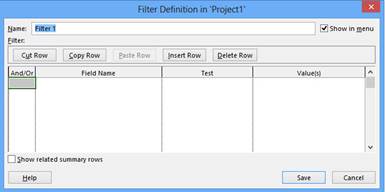
Type a name for the filter in the Name field.
Click the first line of the Field Name, then click the down arrow to display your list of choices.
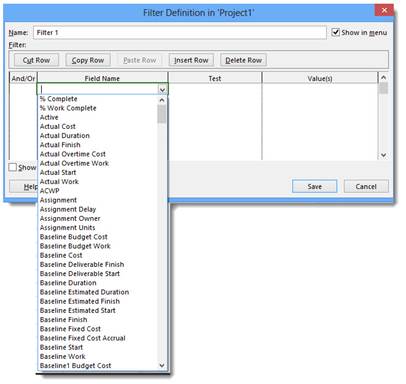
Click a Field Name to select it.
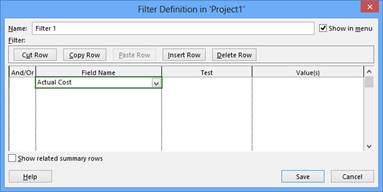
Repeat these steps for the Test and Value(s) columns.
-
Test means a condition that must be met.
-
Value(s) is a value that you enter such as a date or cost, or a predetermined value such as a baseline cost.
If you want this filter to show in the menu when you click on the filter button on the formatting toolbar, check Show in Menu at the top right hand corner of the dialogue box.
Creating Groups
The group feature allows you to organize information by certain criteria.
To apply a predefined group:
Go to either a Resource view or Gantt chart view. We are going to go to Gantt Chart view.
Under the Format tab in the Data group, go to Group By and click the downward arrow, as shown below.
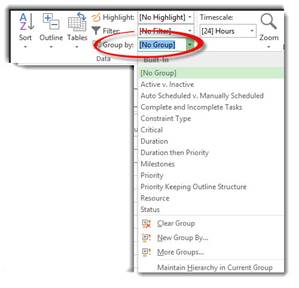
Select your criteria.
Creating Custom Groups
A custom group has three elements: field name, field type, and order. An example would be if you created a group that showed the field name and field type in a certain order (descending or ascending). A group that was created to show tasks in descending order would list tasks in order from the longest to the shortest duration. You can also control the font that is used in different groups or the font color.
To create a custom group, select More Groups in the dropdown menu pictured above.
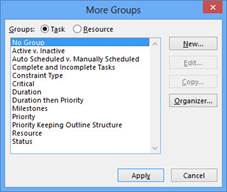
Select if you want to group by Task or Resource, then click New.
Now you will see the Group Definition dialogue box.
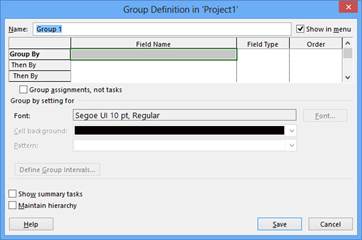
Name your group, then click the first line in the Name Field column. As we did with filters, a down arrow will now appear. Select a field name.
Repeat these steps for the Field Type and Order.
If you want to add more sorting criteria, click the row titled then by. You can keep adding criteria for your group by doing this. You can also check to have assignments, not tasks, grouped by clicking the Group assignments.
In the next section of the dialogue box, you can specify font, the background color for your cells, and the pattern.
If you click the Define Group Intervals button, you can set a start time and an interval. For example, if the Group By criteria is Standard Rate and you select an interval of $10.00, your groupings would be in ten dollar intervals with $0-$10 in one group and so on and so forth.
Creating Templates
Templates are simply files that you create and save that have certain settings. Just think of a website template. More than likely, you've used one before. The template has text and picture fields created for you, and also some formatting. It makes it a lot easier. So will your Project templates that you create because you can save your own settings.
Any template you create will be saved as a Project document. You can save any of your projects as templates. This is especially handy to do if you use a lot of the same tasks over and over in different projects.
In addition to tasks, these following things can also be saved in projects:
-
All the information for each baseline.
-
Actual values
-
Rates for resources
-
Fixed costs
To save a file as a template, open the file that you want to save and then go to File>Save As.
Microsoft saves templates in a folder called Templates.
In the Save As Type list, select Project Template.
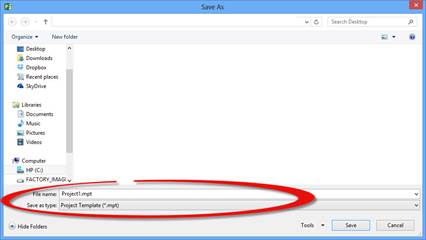
Click the Save button.
When you do, the Save as Template dialogue box appears.
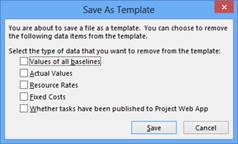
Put a check by the items that you do NOT want to save in your template, then click Save.
Resource Management
The key to successful projects and excellent project management is finding the right resources. What makes a resource right for your project will be based on a couple of contributing factors.
Some of these factors are:
-
The resource must have the right skills or attributes for the task. If the resource is a person, you want to make sure they're trained or at least trainable. However, if they must be trained, make sure you have the budget to train. Having an unqualified or inexperienced resource can interrupt timing, delay tasks, and end up costing you a lot of time and money.
-
The resource must have enough time to complete the task according to your schedule. You won't want a resource that is so busy with other things that your task won't be completed on time.
-
The resource must have the ability to commit to your task. If you have to get permission from someone else to use this resource, do so before you assign the resource to a task.
-
The resource must have a cost that fits your budget.
These are just the basic requirements for a resource. You must also consider other factors such as whether the resource can work with your team and if they have access to the technology to communicate and share with you. Do not forget to keep in mind how well this resource will work with the rest of the team, and if they're going to be reliable or not. These are all important to the timing of your task and the project as a whole.
You need to find a resource for a task in Project. Perhaps the task is one that you need to assign an employee or contractor to it. However, which employee or contractor fits your budget and skills requirements? Which of them is available to work and get the task done?
Project 2013 has two days that you can find resources within the program.
First, can categorize resources by skill or any other criteria using the Resource Information dialogue box.
The Resource Notes area of this dialogue box lets you jot down information about the resource's skills and abilities. To access Resource Notes, double click on a resource name in the Resource Sheet view to bring up the Resource Information dialogue box. Click the Notes tab, as pictured below.

In the Notes field, you can write down notes about the resource, such as skill and availability.
The Code Field under the General tab in the Resource Information dialogue box allows you to rank resources by cost, skill, or the ability to work with others.
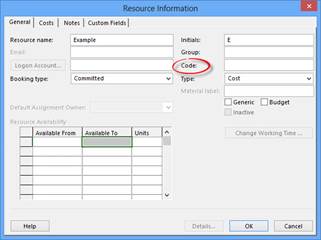
The Custom Fields tab allows you to note specific skills and search for resources by those skills.
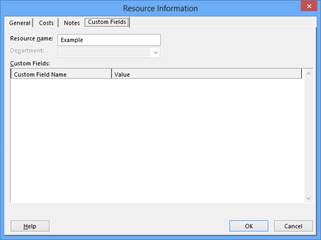
Locating Resources When You Need Them
To find a resource when you need it, first make sure a resource view is showing. Then go to the Task tab and click downward arrow to the right of Find.

Select Find.
In the Find dialogue box (pictured below), type the text you want to find in the Find What field.
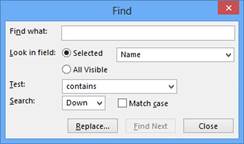
In the Look in Field list, select a field name you want to search.
In the Test box, choose a criterion.
Choose Up in the Search field if you need to search backward from your current location (selected cell). Otherwise, chooseForward.
To begin searching, click the Find Next button to find the next occurrence of what you are looking for in Project.
It is very important that as the project manager, you also manage the resources that are allocated to tasks and make sure that those resources are going to be available for the task when you need them to be. This is critical if you are going to stay on schedule. You do not want your resources to be overbooked.
In this section, you are going to learn about managing availability and allocation at the same time. This is because they go hand in hand. You cannot allocate a resource that's not available. And if a resource is available, you have to make sure that you do not over allocate it.
There are three things you can do to make sure that your resources are available and do not become over allocated.
You can keep an eye on your project plan. By going to the Resource Graph view, you can spot overbooking on tasks.
You can track the workload of individual resources. Take note of people who have to put in a lot of overtime just to keep up with the schedule. They may be over allocated, and you do not want them to burn out.
To track resources, go to the Resource Usage view. Go to the Resource Name column and select the resource that you want to track. The tasks that are assigned to the resource are listed underneath your resource's name.
Ask your resources. Take the time to ask if everything is going okay. If someone is overworked or running behind, you can adjust the schedule or bring in other resources.
If you ever discover that a resource has been over allocated and you need to change this situation to keep on schedule for the project, there are quite a few things you can do. As a project manager, you will want to take action immediately so that your resource does not remain bogged down and cause unnecessary delays or conflicts. This may require changing resource assignments as well as any number of other remedies.
These remedies include:
-
Reassigning the task
-
Adding an extra resource
-
Delaying a task
-
Substitute resources
-
Increase the span of dates that resources are available to increase availability. This may mean granting overtime.
-
Decrease task duration
Resource leveling sounds like you are going to go in and destroy all your resources because they dared to fall behind on schedule. But it is not. Resource leveling is actually a calculation that Project does to try to help you resolve over allocation of your resources.
When you level a resource, you can make changes on your own or let Project do all the calculations for you. If a resource is over allocated, Project delays all tasks that involve over allocated resources and use up any available slack. When there is not any more slack available to use, Project then makes changes based on priorities you've entered for tasks and dependencies, as well as task constraints such as Finish No Later Than. If you do not agree with the changes Project would make, you can reverse the actions.
To level resources:
Go to the Resource tab. Click Leveling Options

You will see the Level Resources dialogue box as shown:
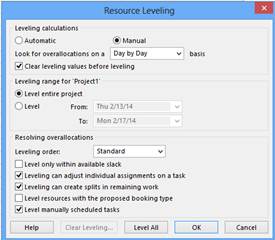
-
Choose Automatic or Manual.
1. Automatic lets Project level your resources every time you change the plan.
2. Manual means that you will have to return to this dialogue box every time and click the Level Now button.
-
If you select Automatic, enable Clear Leveling Valuesbefore Leveling check box. This makes it so previous leveling actions will be reversed before you level the next time.
-
Now, set the leveling range. You can either Level Entire Project, or Level a date range.
-
Click the arrow beside the Leveling Order to make a choice.
-
Standard will consider slack, dependencies, and constraints.
-
ID Only will delay or split tasks with the highest ID. That means it will be the last task in the project.
-
Priority, Standard considers task priority as the first criteria when making choices to split or delay tasks. This is instead of using up slack.
-
Select from the four check boxes to decide how Project will level.
1. Within Available Slack means that none of your critical tasks are delayed. Your finish date for the project will be maintained.
2. Adjusting Resource Assignments means that Project may remove or change assignments.
3. Splitting tasks only for unstarted work in the project means that some tasks will be put on hold until resources for the task become available.
4. Relative to booking type: Booking typerelates to how firm you are set in using that resource. When we created resources, you probably noticed the Confirmed or Proposed booking type. Confirmed would mean that you are set on using it while proposed means you are not.





























